Cloaking Earthquakes
May 9, 2013
We’ve cloaked against radar, microwaves, acoustic waves, light waves, and more,1 but what about seismic waves? Scientists have now found a way to make buildings “invisible” to the destructive force of earthquakes.
What is Cloaking?
Cloaking renders objects undetectable, but what is cloaked and what is the detector varies for different applications. For example, human sight requires light from the object to enter our eyes, or we have to observe a reduction in light (e.g. a black object absorbs light). To make an object undetectable to human eyes, the light waves must go around or directly through the object. None of the light should reflect off of the object and enter the eye (our detector).
B2 bombers are an excellent example of cloaking an object from radar waves. Since the 1990s, research on cloaking has greatly expanded to include microwaves, acoustic waves, light waves, water waves and more.1
Earthquakes also send out energy in waves – seismic waves. Since we can cloak objects from other types of waves, scientists have recently sought a way to hide objects from seismic waves.
Seismic Hide and Seek
For the application of earthquakes, the “detectors” are structures vulnerable to earthquakes. In other words, cloaking an object from seismic waves means shielding important structures from the destructive waves caused by earthquakes.
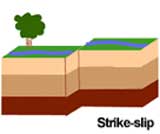
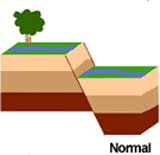
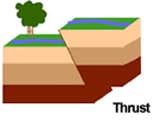
Types of faults where earthquakes originate due to movement along fault lines. Click on each image to see a Flash Animation of how the land moves along the fault line.
Image and Flash Animation Credit: U.S. Geological Survey.
Sudden movement between layers of Earth near fault areas causes earthquakes.
When such movements occur due to a slip on a fault, the ground shakes and sends two types of waves: body waves that carry the energy through Earth (P and S waves) and surface waves that carry the energy along or near Earth’s surface (Rayleigh and Love waves). The waves that travel along or near Earth’s surface cause the ground that we stand on to shift upward, downward, and side-to-side. The surface waves cause the most damage to structures
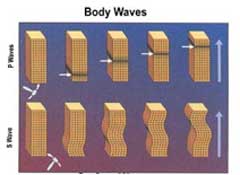
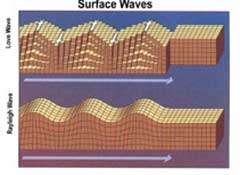
Types of seismic waves.
Image Credit: U.S. Geological Survey.
Measuring Quakes
Earthquake waves are measured using a seismometer, which have a long history. The first seismometer dates back to ancient China in 132 AD, and they have evolved considerably. Nonetheless, the same principle of inertia applies to all of them.
The principle of inertia, known as Newton’s First Law, states that an object will not change its motion unless an overall force acts on the object. In other words, if an object is at rest or moving with constant speed and direction, it will remain in that state unless there is an overall push or pull on it. So how does this work in seismometers?
In the middle seismometer in the image below, a fixed base sits on Earth with a suspended mass hanging from a string. When the ground below the seismometer moves, the base of the seismometer moves with it while the mass remains stationary relative to the ground. Usually this relative motion between the base and mass is converted to a proportional electrical signal that is recorded and analyzed to determine the motion of the ground.
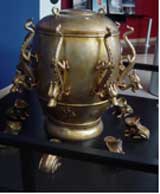
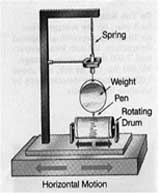
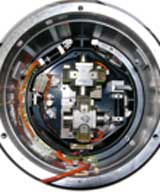
Seismometers. (a) 172 AD, China. (b) A common seismometer. (c) A Modern Seismometer.
Image Credits, respectively: (a) Shizhao (b) US Geological Survey (c) Hannes Grobe
A graph produced from a seismometer is shown below.
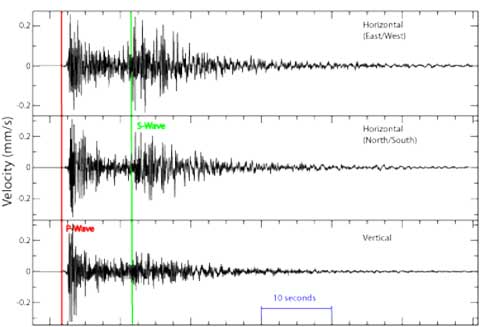
Seismograph showing S-wave and P-wave.
Image Credit: Crickett
The international community has agreed upon having a network of seismometers to better understand earthquakes, volcanoes, and for purposes of detecting detonations of bombs.
Invisible Buildings
The work on cloaking seismic waves utilizes metamaterials – materials that are placed in a highly ordered way, giving the entire structure properties beyond the material’s normal properties.1 Computer simulations in 20094 by researchers in Marseille, France and Liverpool, England showed that layered concentric rings of various materials were able to deflect computer generated waves ranging from 30Hz to 150 Hz, a range that includes acoustic frequencies and some seismic surface wave frequencies.
Researchers hope that this could lead to the development of protective rings that shield buildings during earthquakes.4 In 2013 multiple research groups in Europe, Asia, and the USA are actively pursuing this goal.
French researchers2 at Institut Fresnel (Aix-Marseille University, Centre National Recherche Scientifique, and Ecole Central Marseille), partnered with the French geotechnical engineering company Ménard, which works with preparing the ground before large structures are built on it. This partnership and support from the European Research Council led to an experiment on cloaking seismic waves whose results are rather astounding, but somewhat expected.
The team picked out an area near Grenoble France, and they planned to create a metamaterial in the soil. This would be done by drilling deep holes in the area’s soft soil with cranes. Numerical simulations suggested that this would deflect a seismic wave, but with uncertainties in the soil parameters, they weren’t sure if the cloaking effect would hold up to experimental tests.
Before altering the land in any way, the researchers needed to know how a seismic wave traveled through the land. They created a 50 Hertz seismic surface wave and measured how these waves traveled through the land using an array of 20 sensors.2 They conducted four trials and obtained a good sense of how the waves traveled through the ground.
They then created the metamaterial. They drilled thirty holes in three rows of ten holes each. The rows were not lined up. Each hole was 5 meters deep and had a diameter of 0.32 meters. The holes were placed 1.73 meters apart. This spacing is selected based on the wavelength of seismic surface waves, which were 1.56 m in their experiment. With the 20 detectors all in place, they again set off a seismic surface wave and made their measurements.
The seismic surface waves were almost nonexistent after the first row of boreholes, and nearly immeasurable after the second!2
By boring specially sized and placed holes in the ground, it gave the ground new properties. When the waves reached this section of the ground they had to interact with basically a new material. Whenever a wave reaches the boundary between two materials it can be transmitted through, absorbed by, and/or reflected off of the new material. In this particular case, the seismic waves were almost completely reflected off of the boundary between the regular ground and the ground with bored out holes.
The downside to this is that the waves are reflected backwards, meaning that if there were any buildings on the wrong side of this type of seismic cloak, they would experience an increase in seismic activity. However, this is not a concern for isolated structures such as oil refineries, power plants, nuclear reactors, and some monuments.
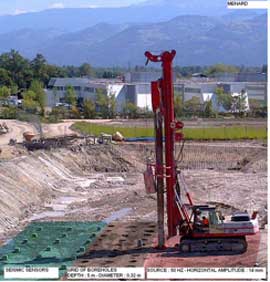
Photo of the experimental setup. The Sensors are located in the green colored area. The bore holes are located in the brown colored region. The seismic wave is produced in the red colored region.
Image Credit: Ménard Company
Other theoretical research5 has suggested using meta-cylinders with side holes, which would dampen the seismic surface waves and hence reduce the amount of seismic energy reflected from the metamaterial. Dampening of the seismic waves means transforming some of the energy carried by those waves to another type such as sound and heat.
Boring deep, thin cylindrical holes in the ground is relatively easy to do (for a company like Menard). And stopping an earthquake’s surface waves dead in its tracks by the second row of these holes is just amazing! So why not have a few rows of these around important isolated structures. The first two rows could stop a quake from proceeding, and having a few more rows just in case seems easy enough.
Of course, there are other issues. There are many frequencies of seismic surface waves, and each requires slightly different boreholes. It is important to consider the type of ground too, which will affect the way the structure of the boreholes.
Luckily the experiments continue. According to Sebastien Guenneau of Institut Fresnel, another large-scale experiment has been performed near Lyon, France for a seismic frequency of about 10 Hz, with a 30% reduction in forward moving seismic energy. The metamaterial consisted of 20 bored out holes. Genneau also stated that seismic wave sources between 0.1 to 10 Hertz are especially damaging to buildings, so these will be studied next by the Menard Company in collaboration with Institut Fresnel.
International Monitoring
Already there is an international network of seismometers on land and in the ocean that were put in place not just to detect earthquakes, but also to detect explosions in mines and nuclear blasts. When an explosion occurs it also sends a seismic wave traveling through Earth. The signature of a detonation is different from an earthquake. For an earthquake the ground starts shaking slowly and then increases, for a blast it begins shaking rapidly and decreases.
Some nuclear blasts do set off earthquakes, but the blast is still detectable. However, a nuclear blast can be “hidden” by conducting it near a mine site, hence making it seeming to be a mine explosion. Some may be concerned of cloaking a blast. The type of cloaking mentioned here hides surface waves basically behind a screen of bored out holes. It does not “hide” body waves (those that travel through Earth). However in principle, one should be able to cloak any wave.
Often detection of nuclear blasts rely on nuclear isotopes found in air samples, which are hard to hide, but may be contained if the explosion is underground and contained at a sufficient depth (greater than 100 m and proportional to depth divided by the cube root of the explosion in kilotons).9 Detection may then have to rely on future improvements to satellite imagery of Earths layers because underground blasts do leave a marked difference in the surrounding material due to sudden high temperatures causing melting and vaporizing of surrounding rock, which then cool.
Sometimes there is a slight uplift (e.g. 2 inches) or collapse on the surface, but this can occur up to four years later.10 Currently satellites can detect a thermal signature, which might be noted but not conclusive to a nuclear blast. Radar ground penetration and electromagnetic induction instruments require locally made measurements and their imaging depth depends on the ground material. The general depth of these techniques is about 30 m (much less than the depth an underground nuclear blast should occur).
You can learn more about this international system in this week's podcast.
Future Research
The area of cloaking continues to grow and expand to more wave types. This particular area of cloaking seismic waves, according to Dr. Guenneau, “should help civil engineers to better understand how surface seismic waves might interact with large periodic structures, in order to reflect or detour Rayleigh waves. This can be useful to protect old or fragile monuments in seismic regions, by structuring the soil around the monument (just drilling holes with the required diameter, depth, and spacing). One might even foresee some anti-earthquake protection for cities, such as San-Francisco or Istanbul.”
Imagine earthquake-proof cities - as long as there is not a fault below it! And who knows, maybe someday someone will figure out a way to harness some of this energy.
References and Resources
1. Doss, H., Cloaking – Making something appear invisible, Physics in Action, Physics Central, May 2011http://www.physicscentral.com/explore/action/cloaking.cfm
2. Brulé, S., et al., Seismic metamaterial: How to shake friends and influence waves,” arXiv.org > physics> geophysics,
http://arxiv.org/abs/1301.7642
3. Brun, M., Guenneau S., and Movchan, A.B., Achieving control of in-plane elastic waves, Appl. Phys. Lett. 94, 061903 (2009)
http://apl.aip.org/resource/1/applab/v94/i6/p061903_s1?isAuthorized=no
4. Farhat, M., et al., Ultrabroadband Elastic Cloaking in Thin Plates, Phys. Rev. Lett. (103) 2, 024301 (2009)
http://prl.aps.org/abstract/PRL/v103/i2/e024301
5. Sang-Hoon Kim and Mukunda P. Das, Seismic Waveguide of Metamaterials, Mod. Phys. Lett. B 26, 1250105 (2012)
http://www.worldscientific.com/doi/abs/10.1142/S0217984912501059
6. Treacy S., How to Repel an Earthquake, Science Now, 14 Feb 2013
http://news.sciencemag.org/sciencenow/2013/02/how-to-repel-an-earthquake.html?ref=hp
7. Beradelli, P., A “Cloaking Device” for Earthquakes, Science Now, 24 July 2009
http://news.sciencemag.org/sciencenow/2009/07/24-02.html
8. Lane, E., Technology Improving Detection of Nuclear Tests, Experts Say at AAAS Capitol Hill Event, AAAS website, 17 October 2012
http://www.aaas.org/news/releases/2012/1017nuclear_test.shtml
9. Wikipedia, Underground Nuclear Testing
http://en.wikipedia.org/wiki/Underground_nuclear_testing
10. Satellite Imagery Detects Thermal 'Uplift' Signal of Underground Nuclear Tests, Science News Daily, 10 Jan 2012
http://www.sciencedaily.com/releases/2012/01/120110151712.htm
11. Ground Penetrating Radar and Electromagnetic Induction measurements.
http://www.geophysical.com/gssifaqs.htm
—Heide Doss














